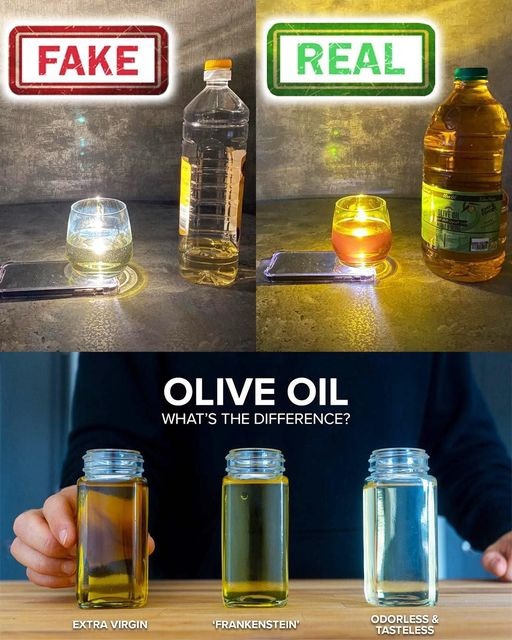False olive oil is defined as olive oil that has been chemically changed or blended with inferior oils in order to make it seem and taste like real olive oil. It doesn’t always taste as good as genuine olive oil and doesn’t have the same health advantages.
Olive Oil that Is Flavorless and Odorless
After going through all that processing, the olive oil lost all of its inherent scents and qualities, leaving it bland and odorless. The quality is inferior to that of extra virgin olive oil, although it is not fraudulent.
Ways to Tell Authentic Olive Oil by Its Translucency As a test, fill a clear glass with olive oil and set it on top of your phone’s flash. Press the shutter button and look at the oil under the light. The Magic Behind It:
A little cloudiness and a natural greenish-golden tint are hallmarks of real olive oil. Due to the addition of additives, adulterated oils might seem excessively transparent or fluorescent.
Method for Testing in the Refrigerator: Chill a little olive oil for about half an hour. As it cools, real olive oil will set and become a murky color. The reason it works is because unlike many synthetic oils, real olive oil solidifies when exposed to low temperatures because it includes monounsaturated fats.
How to Test Olive Oil by sniff and Taste: Take a little olive oil and sniff it. A fruity scent and a somewhat bitter, peppery flavor characterize authentic olive oil. The rationale for its efficacy is that, unlike synthetic or overly processed oils, real extra virgin olive oil has a unique scent and taste.
As a quality control measure, look for information on the harvest date, the area of origin, and certification marks from respected organizations on the label of the bottle. The Reason It Works: Reliable sources provide extensive details on the whereabouts and quality of the oil. A warning sign can be the absence of such details.
Method for Checking Prices: Look at how much various olive oils cost. Prices that look too good to be true usually are. The rationale for its effectiveness is that premium extra virgin olive oil is pricier and requires more meticulous processing. Very cheap costs could be a sign of fraud.
A little olive oil heated in a skillet is a good starting point for a cooking behavior test. A little smoke and a delicious aroma are telltale signs of high-quality olive oil. The Magic Behind It: A greater smoke point and a distinct aroma when heated are telltale signs of adulterated oils.
The Significance of Being Alert
Continue Reading in next page

